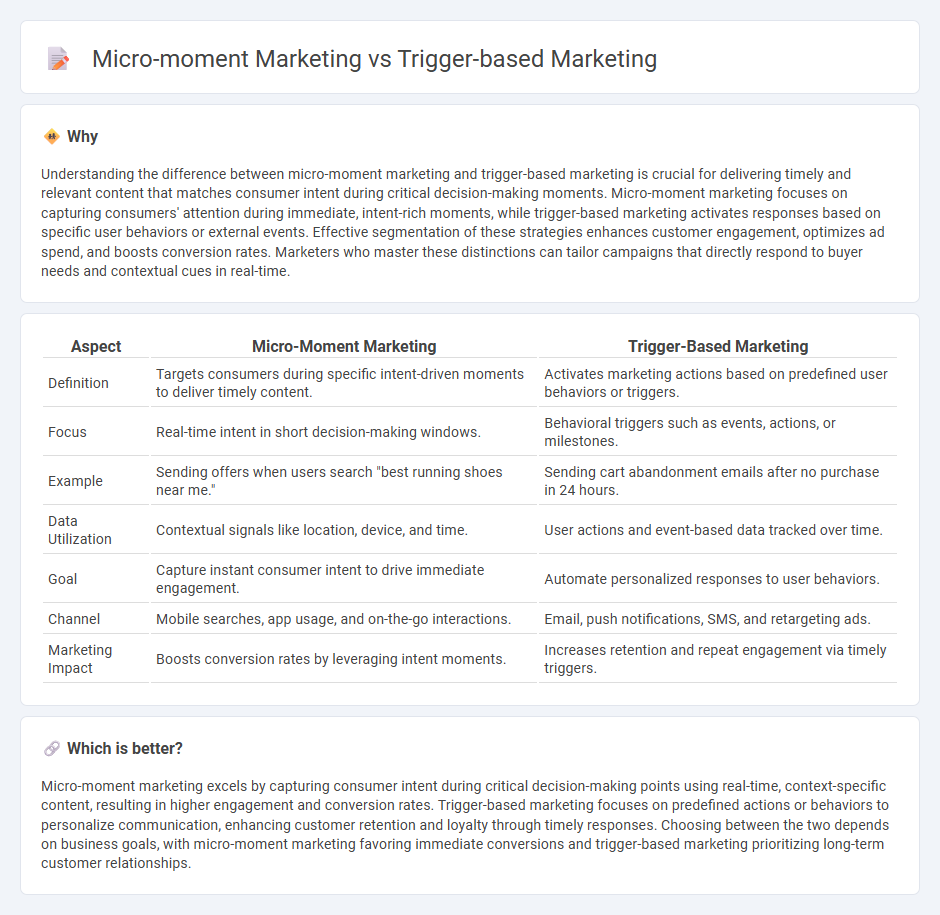
Micro-moment marketing capitalizes on real-time consumer intent by delivering targeted content during critical decision-making instances, leveraging mobile and location data to enhance relevance. Trigger-based marketing focuses on predefined user actions or behavioral cues, initiating personalized communication sequences to drive engagement and conversion. Explore the distinct strategies and benefits of micro-moment and trigger-based marketing to optimize your digital campaigns effectively.
Why it is important
Understanding the difference between micro-moment marketing and trigger-based marketing is crucial for delivering timely and relevant content that matches consumer intent during critical decision-making moments. Micro-moment marketing focuses on capturing consumers' attention during immediate, intent-rich moments, while trigger-based marketing activates responses based on specific user behaviors or external events. Effective segmentation of these strategies enhances customer engagement, optimizes ad spend, and boosts conversion rates. Marketers who master these distinctions can tailor campaigns that directly respond to buyer needs and contextual cues in real-time.
Comparison Table
| Aspect | Micro-Moment Marketing | Trigger-Based Marketing |
|---|---|---|
| Definition | Targets consumers during specific intent-driven moments to deliver timely content. | Activates marketing actions based on predefined user behaviors or triggers. |
| Focus | Real-time intent in short decision-making windows. | Behavioral triggers such as events, actions, or milestones. |
| Example | Sending offers when users search "best running shoes near me." | Sending cart abandonment emails after no purchase in 24 hours. |
| Data Utilization | Contextual signals like location, device, and time. | User actions and event-based data tracked over time. |
| Goal | Capture instant consumer intent to drive immediate engagement. | Automate personalized responses to user behaviors. |
| Channel | Mobile searches, app usage, and on-the-go interactions. | Email, push notifications, SMS, and retargeting ads. |
| Marketing Impact | Boosts conversion rates by leveraging intent moments. | Increases retention and repeat engagement via timely triggers. |
Which is better?
Micro-moment marketing excels by capturing consumer intent during critical decision-making points using real-time, context-specific content, resulting in higher engagement and conversion rates. Trigger-based marketing focuses on predefined actions or behaviors to personalize communication, enhancing customer retention and loyalty through timely responses. Choosing between the two depends on business goals, with micro-moment marketing favoring immediate conversions and trigger-based marketing prioritizing long-term customer relationships.
Connection
Micro-moment marketing capitalizes on immediate consumer intent by delivering targeted content during brief decision-making windows, while trigger-based marketing activates personalized campaigns in response to specific user behaviors or external stimuli. Both strategies leverage real-time data and contextual awareness to engage consumers precisely when their interest or need arises. Integration of these approaches enhances customer experience by anticipating and responding to critical interaction points throughout the buyer's journey.
Key Terms
Trigger-based marketing:
Trigger-based marketing leverages specific events or customer actions, such as a website visit or cart abandonment, to initiate personalized communications that increase conversion rates and foster customer loyalty. This data-driven approach uses real-time analytics to respond instantly to consumer behavior, enhancing relevance and engagement. Explore how integrating trigger-based marketing can transform your customer interactions and boost ROI.
Event triggers
Trigger-based marketing leverages specific events such as cart abandonment or location check-ins to deliver targeted messages that prompt immediate consumer action. Micro-moment marketing captures real-time consumer intent in critical moments, like searching for nearby services on mobile devices, optimizing personalized responses within seconds. Explore how integrating event triggers can elevate your marketing strategy with timely relevance and increased engagement.
Automated campaigns
Trigger-based marketing leverages specific customer actions, such as website visits or email clicks, to automatically initiate personalized campaigns that enhance engagement and conversion rates. Micro-moment marketing targets precise moments when consumers seek immediate information or decision-making, delivering relevant messages through automated campaigns at the point of intent. Explore how these automated marketing strategies can be tailored to maximize customer interaction and drive sales efficiently.
Source and External Links
Trigger Marketing: Types, Examples and Strategies for 2025 - Trigger marketing uses specific customer behaviors, events, or conditions to automatically launch personalized marketing campaigns, aiming to boost engagement and conversions by delivering timely, relevant messages.
Trigger-Based Campaigns Done Right: Ideas & Examples - Trigger-based campaigns automate personalized communications--such as emails or notifications--in response to customer actions, leading to higher open rates, improved customer satisfaction, and increased loyalty.
Trigger Marketing: What it is, Best Practices, and Examples - Trigger marketing sends targeted messages through the most appropriate channels at the optimal moment, based on customer behavior or specific events, enhancing relevance and response rates.
 dowidth.com
dowidth.com